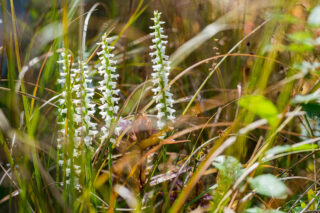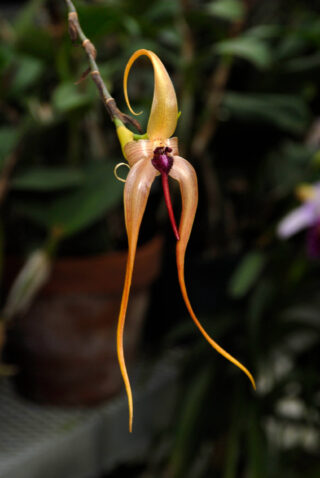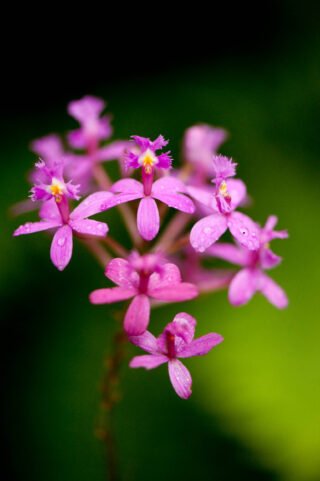The Foundation of Global Orchid Conservation
Matthew Pace, Ph.D., is the Assistant Curator of the Herbarium The New York Botanical Garden.

Orchids are the kings of plant superlatives: They are the most species-rich plant family, with 28,000 known species. Bulbophyllum, Epidendrum, Habenaria, and Stelis are among the most species-rich genera of plants, each with over 1,000 known species. Orchids are found in almost every terrestrial environment, from the Amazon to the Arctic.

But, some of these superlatives are less welcome. For example, all orchids are listed on the CITES treaty, which governs the international exchange of rare species. Eight US orchids are listed on the Endangered Species Act. 56% of all orchids are threatened with extinction, making them one of the most at-risk plant groups [1]. This means more than half of all orchids could face extinction within our lifetime. These are sobering statistics, but the New York Botanical Garden has the tools to help address this crisis. “How so,” you may ask? As recently described by Mauricio Diazgranados, Ph.D., the Chief Science Officer and Dean of the International Plant Science Center: “NYBG is a world leader in plant, algal, and fungal research and conservation, using traditional and cutting-edge tools to discover, understand, and preserve Earth’s vast biodiversity” [2]. We provide the global research community with the data to understand and characterize orchid diversity, allowing scientists to identify and distinguish any one orchid species from the other 27,999 species. We know where these species occur, so we can understand how diversity is spread across the globe and know where conservation attention is most urgently needed. In short, we can protect a species if we have a name for it and if we know where it grows.
The NYBG Steere Herbarium holds 57,230 preserved orchid specimens, documenting species from across the globe. We are the 7th largest herbarium collection of orchids, which is impressive considering NYBG did not have a staff research curator who specialized in this family until the 1990’s. To help make our critically important conservation data available to the global research community, NYBG led a 2018 NSF award called “The Endless Forms Thematic Collections Network” [3]. This award, in which NYBG led a dozen US based herbaria, universities, and botanical gardens, digitized 2 million herbarium specimens of epiphytic, carnivorous, and succulent plants, including iconic species such as the ghost orchid (Dendrophylax lindenii), Venus fly trap (Dionaea muscipula), and saguaro cactus (Carnegiea gigantea). Many of the species included in this NSF award are of extreme conservation concern, and this award allowed NYBG to digitize our entire orchid herbarium collection. NYBG’s digital orchid herbarium specimen data has already made an outsized research impact, playing a critical role in several recent major studies of orchid biodiversity [4] and conservation needs [5]. Looking to the future, NYBG digital orchid specimen data will be used in every major orchid conservation paper, making real-world impacts to research and conservation.

Finally, it’s important to remember that our picture of global orchid diversity is still incomplete, and dozens of new orchids are named and described every year. To help complete this picture, I described two new orchids in 2020 that I first discovered in our William and Lynda Steere Herbarium, one of which is only known from a single specimen [6]. In 2021, I described another new critically imperiled species from the greater NYC metro area [7]. And just this month, NYBG graduate student Simon Verlynde was part of an international team to describe a spectacular new species of orchid from Madagascar, which has the longest nectar spur of any known plant [8]. Orchids face many threats, but the cutting-edge research of NYBG and our partners are helping to ensure we can conserve these amazing, superlative plants.
[1] Antonelli et al. 2023. State of the World’s Plants and Fungi. State of the World’s Plants and Fungi 2023. Royal Botanic Gardens, Kew. DOI: https://doi.org/10.34885/wnwn-6s63
[2] Diazgranados. 2023. COP28: Science Has Never Been More Important. Plant Talk series. https://www.nybg.org/planttalk/cop28-science-has-never-been-more-important/
[3] Award Abstract # 1802034 Digitization TCN: Collaborative Research: Digitizing “endless forms”: Facilitating Research on Imperiled Plants with Extreme Morphologies. National Science Foundation. https://www.nsf.gov/awardsearch/showAward?AWD_ID=1802034
[4] Pérez-Escobar et al. 2024. The origin and speciation of orchids. New Phytologist, https://doi.org/10.1111/nph.19580
[5] Carmona-Higuita et al. 2024. Conservation status of vascular epiphytes in the neotropics. Biodiversity and Conservation 33: 51–71. https://doi.org/10.1007/s10531-023-02730-8
[6] Pace 2020. New species of Microchilus and Pelexia (Orchidaceae) from the Yungas and western Amazonia of Bolivia and Peru. Brittonia 72, 141–153. https://doi.org/10.1007/s12228-020-09612-1
[7] Pace. 2021. Meet Spiranthes bightensis: A New Orchid in Our Own Backyard. The Hand Lens https://sweetgum.nybg.org/science/the-hand-lens/explore/narratives-details/?irn=7532
[8] Farminhão et al. 2024. A new orchid species expands Darwin’s predicted pollination guild in Madagascar. Current Biology, https://doi.org/10.1016/j.cub.2024.01.012
SUBSCRIBE
Enter your email address to subscribe to this blog and receive updates on new posts.











